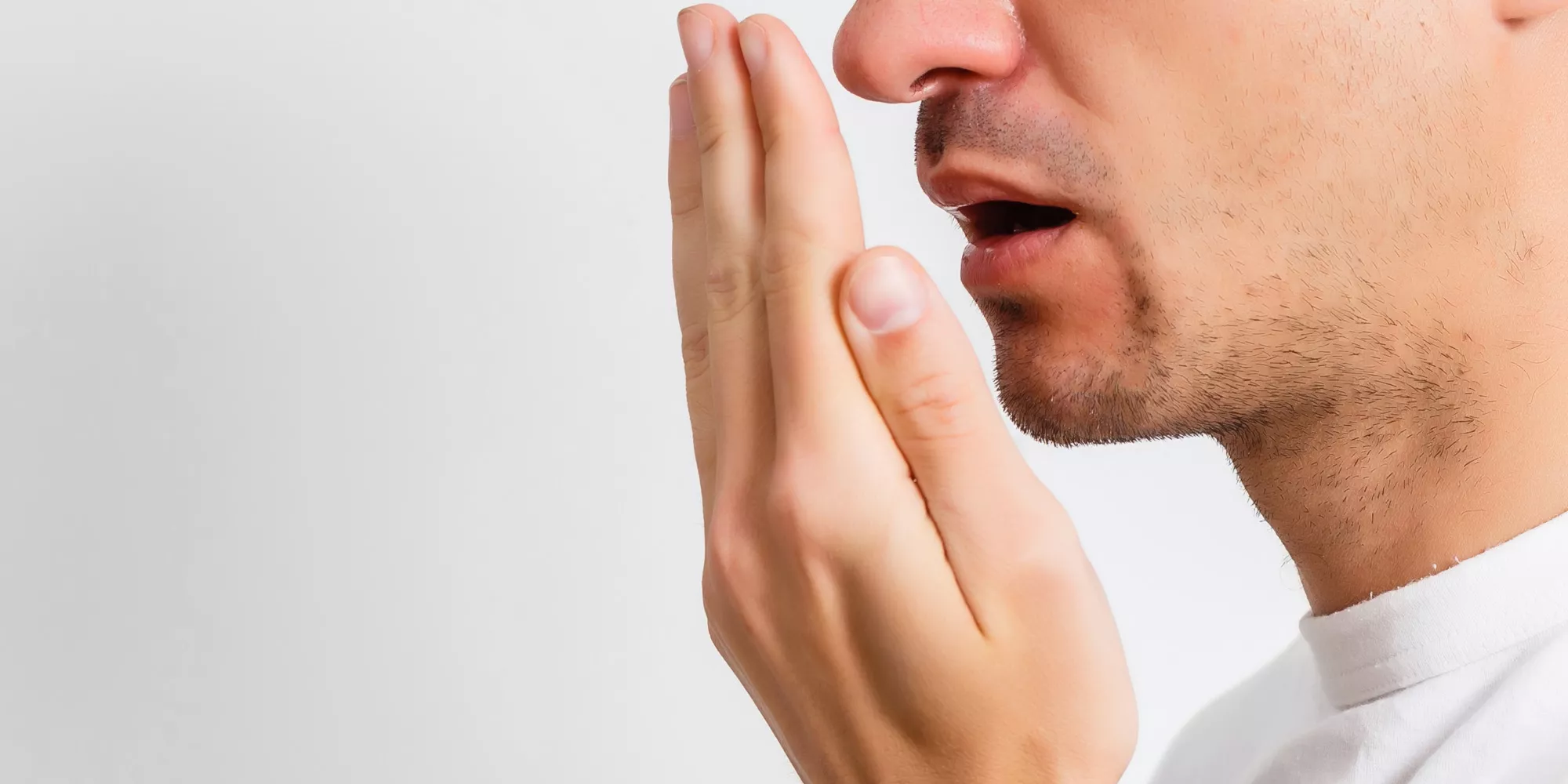Bad breath is a common health problem that greatly affects the day-to-day activities of so many people. The offensive odor from the mouth is unpleasant to those who come in close contact with bad breathers. The problem will be doubled by psychological trauma leading to depression. The sufferers of this problem will be isolated from society. This can even lead to marital disharmony.
Literally speaking all human beings are bad breathers.
The oral cavity contains millions of anaerobic bacteria like Fusobacterium and actinomyces which act on the protein of food materials and putrefies them. This process results in the formation of offensive gases like hydrogen sulfide, methyl mercaptan, cadaverine, skatol, putrescine, etc causing a bad odor. If oral hygiene is not maintained properly all will suffer from bad breath. Most of us control this by regular brushing, tongue cleaning, and gargling. Even after maintaining cleanliness in the mouth, some individuals suffer from offensive smells due to various causes which have to be diagnosed and treated properly.
Some common causes of bad breath.
1) Poor oral hygiene:

If oral hygiene is not maintained properly the mouth becomes the seat for millions of bacteria that produce offensive gases by degrading the food debris. Bad breath is severe in those who do not brush their teeth regularly and clean their mouth after every food. Snacks taken inbetween meals can also produce bad breath because of improper cleaning.
bad breath is common in almost all people in the morning on waking. During sleep, there is less production of saliva. Saliva has got some antibacterial properties that help to keep the mouth clean. Saliva contains oxygen molecules that are needed to make the oral cavity aerobic. So the reduction in its quantity during sleep makes a favorable condition for anaerobic bacteria.
2) Food habits:

The main cause of the bad smell is due to degradation of protein by the bacteria and hence all food products rich in protein favor’s bad breath. Meat, fish, milk products, eggs, cakes, nuts, pear, etc can cause bad breath. Some food articles can produce a particular type of smell that may be unpleasant. Raw onion can produce a typical bad smell. It is said that an apple a day keeps the doctor away, a raw onion a day keeps everybody away. Eating groundnuts can also produce a bad smell. However, if proper cleaning is done smell can be reduced irrespective of the nature of the food. Irregularity in the timing of food can also produce bad breath. Small food articles taken in between the meals can also produce a bad smell.
3) Biofilm:
There is the formation of a thin sticky coating called biofilm on the tongue and oral mucosa. This coating is thick on the posterior aspect of the tongue where millions of gram-negative bacteriae are seen. The thick coating on the tongue is always associated with bad breath. Even a thin biofilm can make anaerobic conditions favorable for bacterial proliferation.
4) Dental caries:

This is a destructive process causing decalcification with the destruction of enamel and dentine resulting in cavitation of the tooth. These are produced mainly by the lactobacilli. Food particles are deposited inside these cavities and are putrified by the anaerobic bacteria producing a bad smell. Normal brushing will not remove the food debris easily and hence they are putrified completely. Caries is common in schoolgoing children and in those who don’t maintain proper oral hygiene. Calcium and vitamin deficiency can also predispose to caries.
5) Gingivitis:

Gum is a mucus membrane with supporting connective tissue covering the tooth-bearing borders of the jaw. The main function of gum is protection. Gingivitis is the inflammation of the gum. Due to various causes gum tissue gets infected resulting in swelling, pain, and discharge. If the condition becomes worse the infection spread towards peridontal area leading to continuous discharge called pyorrhoea. Sometimes the infection goes deep producing an alveolar abscess with discharge of pus. Infection can even reach the bone causing osteomyelitis. All these conditions can produce an offensive smell.
6) Gum retraction:
When the gums retract from the teeth a gap is developed which will lodge food particles and cause bad breath.
7) Dental plaques and tartar deposits:
Plaques and tartar is deposited mainly in the gaps between the teeth and gum. This will provide shelter for the food debris and bacteria causing bad breath.
8) Ulcerative lesions& coatings:
Almost all ulcerative lesions of the mouth are associated with bad breath. These lesions may be caused by bacteria, viruses, food allergies, or due to autoimmune disorders. Aphthous ulcer is the commonest among ulcerative lesions. Others are herpes, fungal infections, vincents angina, infectious mononucleosis, scarlet fever, diphtheria, drug reactions, etc. Cancerous ulcers produce severe bad breath. All fungal infections produce white coating(candidiasis). Leucoplakia is a white thick patch on the mucus membrane of the mouth & tongue. It is considered a precancerous condition. Offensive breath is associated with these conditions.
9) Diseases of the salivary glands:

Saliva is very useful to supply oxygen to all parts of the oral cavity. Even a thin film of coating called biofilm can provide an anaerobic condition in the mouth. Saliva can wet these layers and make an aerobic condition which is unfavorable for the bacteria. Any condition which reduces the production of saliva can increase bacterial activity. Sometimes the salivary duct is obstructed by stones or tumors. Cancer of the salivary gland is associated with an offensive odor. In suppurative parotitis, purulent discharge into the mouth causes bad breath.
10) Tonsillitis:

Tonsils are a pair of lymphoid tissue situated in the lateral wall of the oropharynx. Inflammation of the tonsil is called tonsillitis. Bad breath is seen in both acute and chronic tonsillitis. Quinsy or peritonsillar abscess can also produce bad breath.
11) Tonsillar plaques & tonsillar fluid:
If bad breath persists even after maintaining proper oral hygiene there is a possibility of this condition. Serous fluid secreted from the folds of the tonsil is very offensive. Some patients complain that they hawk some cheesy materials from the throat; which are very offensive in nature. These are formed inside the tonsillar crypts which contain thousands of bacteria. In such conditions, tonsillectomy gives noticeable relief from bad breath.
12) Pharyngitis& pharyngeal abscess:
The pharynx is a fibromuscular tube that forms the upper part of the digestive & respiratory tract. Inflammation of the pharynx is called pharyngitis, caused mainly by bacteria and viruses. Bad breath is present in pharyngitis along with other signs like cough and throat irritation. Abscesses in the wall of the pharynx can also produce an offensive discharge of pus into the throat.
13) Dentures:
Denture users may complain about bad smells due to the lodgment of small food debris in between. Proper brushing may not be possible in denture users especially with fixed dentures.
14) Tobacco:
Tobacco chewing is associated with bad breath. The smell of tobacco itself is unpleasant for others. Tobacco can irritate the mucus membrane and cause ulcers and coatings. Gingivitis and pyorrhea are common in tobacco chewers. Tartar is deposited on the teeth mainly near the gums. Tobacco chewers get gastric acidity with eructations. All these cause an offensive smell.
15) Smoking:

Smokers always have a bad smell. It can also produce lesions in the mouth & lungs causing bad breath. Smoking increases carbon dioxide in the oral cavity & reduces oxygen levels, causing a favorable condition for bacteria. Smoking reduces appetite & thirst hence acid peptic disease is common in chain smokers.
16) Lesions in the nose & ear:
Bad breath is occasionally seen in sinusitis(infection of para nasal sinuses). In the case of post nasal dripping bad breath is common due to the presence of protein in the discharges. These proteins are degraded by the bacteria. Infection in the middle ear with the discharge of pus into the throat through the eustachian tube(passage from the middle ear to the throat)can also cause an offensive odor. Chronic rhinitis(infection of the mucus membrane of the nose) and foreign bodies in the nose can also produce a bad smell in the expired air.
17) Diabetes mellitus:
Mostly all diabetic patients suffer from bad breath. Coated tongue, ulcers &coatings in the mouth, the increased sugar level in tissues, etc are responsible for bad breath. Bacterial growth in diabetic patients is very faster than in nondiabetic individuals.
18) Fevers:

Bad breath is common in almost all fevers. Even an acute fever can produce bad breath. Severe bad breath is seen in typhoid. Other infectious diseases like Tuberculosis, AIDS, etc produce bad smells.
19) Fasting & dehydration:
A dry mouth favors bacterial activity. So any condition which produces dryness in the mouth makes the breath offensive. Even though the food particles are known to produce bad breath, fasting can also produce the same. Production of saliva is also reduced during fasting. Chewing and swallowing also helps to keep the mouth clean.
20) Bedridden patients:
Bedridden patients suffer from offensive breath due to a thick coating on the tongue. water intake is also limited in these patients. Regurgitation of food aggravates the condition. Since they talk less aeration in the oral cavity is reduced which favors anaerobic bacteria to become active.
21) Diseases of the stomach & esophagus:
The eructation of gas and food produces an unpleasant smell. Abnormality in the function of the lower sphincter can allow the food to regurgitate upwards causing bad breath. Bad breath is also common in gastritis, gastric ulcer, and cancer of the stomach.
22) Intestinal diseases:
Bad breath is common in patients suffering from ulcerative lesions of the intestine like ulcerative colitis…Other diseases are malabsorption syndrome intestinal tuberculosis, peritonitis, etc.
23) Diseases of the lungs:

Lung diseases like pneumonia, lung abscess, chronic bronchitis, bronchiectasis, tuberculosis, lung cancer, etc can produce a bad odor during expiration.
24) Liver disorders:
Liver diseases like hepatitis, cirrhosis, can cause bad breath. Gall bladder diseases with vomiting also cause an unpleasant odor.
25) Psychiatric patients:
Bad breath is common in psychotic patients due to poor hygiene, irregular food habits, less water intake and etc.
26) Somatization disorder:
This is a psychiatric disorder characterized by the presence of a physical symptom that suggests a medical illness. These patients come with physical complaints like pain, nausea difficult respiration, bad smell, etc. This condition is diagnosed after a detailed examination of the patient with all investigations. Since this is a psychiatric disorder it has to be managed with a psychological approach.





GIPHY App Key not set. Please check settings